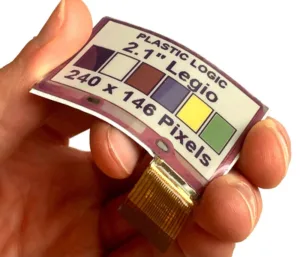E Ink Holdings, the leading innovator of electronic ink technology, and Plastic Logic, a leader in the design and manufacture of flexible, glass-free electrophoretic displays (EPDs), are partnering to provide the world’s first flexible color displays based around E Ink’s Advanced Color ePaper (ACeP™) technology.
Plastic Logic’s advanced oTFT (organic Thin Film Transistor) displays are high-resolution, lightweight and ultra-low-power. They are more rugged than standard glass-based TFTs and being thinner and lighter makes them ideal for applications such as wearables.
E Ink ACeP is a high quality, color reflective electronic paper that can produce full color at every pixel, without the use of a color filter array (CFA). Currently, E Ink’s ACeP display has been used in signage applications that do not require flexible form factors. The addition of Plastic Logic’s technology allows for expansion into applications that can require thinner and lighter weight displays.
“E Ink is excited to partner with Plastic Logic to offer the world’s-first flexible color display technology to customers,” said Johnson Lee, CEO, E Ink. “Plastic Logic’s advanced oTFT displays are more robust than traditional amorphous silicon transistors on plastic substrate, which maybe more suitable for wearable applications.”
“We are very excited to collaborate with E Ink to provide the market with the world’s first plastic displays using ACeP film,” said Tim Burne, CEO, Plastic Logic. “Our flexible, glass-free displays are a perfect addition to any wearable technology designer’s toolkit—they are extremely lightweight, making them well suited for integration into a host of wearables, including smart jewellery and smart clothing.”
He added: “Our new range of LegioTM flexible color displays will enable customers to bring new color applications to market faster and, we believe, more cost effectively. Evaluation Kits will be available later this year so that designers can try out the displays in ‘real world’ applications.”
Legio products are made using oTFT backplanes manufactured by TENFlecs, one of Plastic Logic’s manufacturing partners – illustrating a further important milestone in the company’s strategy to move to a fully outsourced supply.
The increasingly diverse market for wearable devices is expected to reach over $150bn annually by 2026.*
About E Ink
E Ink Holdings Inc. (8069.TWO), based on technology from MIT’s Media Lab, has transformed and defined the eReader market, enabling a new multi-billion-dollar market in less than 10 years. E Ink’s low power products are ideal for IoT applications ranging from retail, home, hospital, transportation and more, enabling customers to put displays in locations previously impossible. The Company’s corporate philosophy aims to deliver revolutionary products, user experiences and environmental benefits through advanced technology development. This vision has led to its continuous investments in the field of ePaper displays as well as expanding the use of its technologies into a number of other markets and applications including smart packaging and fashion. Its Electrophoretic Display products make it the worldwide leader for ePaper. Its Fringe Field Switching (FFS) technologies are a standard for high-end LCD displays and have been licensed to all major liquid crystal display makers in the world. Listed in Taiwan’s Taipei Exchange (TPEx) and the Luxembourg market, E Ink Holdings is now the world’s largest supplier of ePaper displays.
About Plastic Logic
Plastic Logic designed the world’s first truly flexible, glass-free electrophoretic displays (EPDs)—Lectum®. Originally made in Dresden, Germany, production is today carried out in industry-leading manufacturing facilities globally. Founded in 2000, the company is supported by major investors including the Rusnano Corporation and the E INK Corporation, underlining its market and technology leadership position. Plastic Logic’s glass-free, flexible displays have been integrated into a wide range of applications including smart cards, mobile devices (smartphone accessories, eNotes, eSchoolbooks), digital signage, electronic badges and wearables (e.g. smart jewellery and sports accessories).

